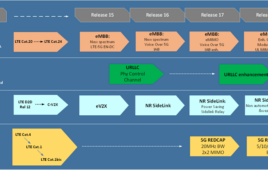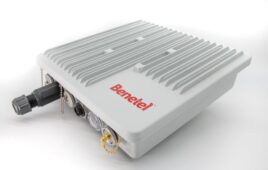of ZigBee’s low power requirements for short range communications.
In the current world of wireless data networks, most of the industry’s focus is on delivered bandwidth, and usually bigger is definitely better. But there is also growing interest in using wireless technologies for short-range applications that require very modest throughput rates and which can be deployed simply by unsophisticated users at very low cost.
This is the domain of a relatively new wireless technology called ZigBee. Based on the IEEE 802.15.4 standards for physical (PHY) and medium access control (MAC) layers of a low bandwidth, low power data communications system, ZigBee is intended to address the sorts of pedestrian short range machine-to-machine (M2M) data connections for which even Wi-Fi networks would be gross overkill. For example, a typical ZigBee application currently being marketed is a wireless  lamp switch. A 110 (or 220) volt switching adaptor is plugged into an ordinary electrical outlet, and the lamp is then plugged into the adaptor. A simple on/off switch wirelessly controls the power switch in the adaptor, allowing the lamp to be turned off remotely.
lamp switch. A 110 (or 220) volt switching adaptor is plugged into an ordinary electrical outlet, and the lamp is then plugged into the adaptor. A simple on/off switch wirelessly controls the power switch in the adaptor, allowing the lamp to be turned off remotely.
SIMPLE BUT ELEGANT
In this example, about the simplest wireless data communications application one could imagine, the remote switch requires just a transmitter and the adaptor requires just a receiver. Because transmissions are of very low power and are only required when the lamp is to be turned on or off, a small hearing aid style battery in the remote switch can last for years. The adaptor can draw a miniscule bit of power from the electric outlet it’s plugged into, so its receiver can simply be on all of the time waiting for a switching command. It sounds very simple and it is; the electronic chips involved can be manufactured for pennies and an adaptor and remote switch set can be sold at retail for a few dollars. But the real elegance of ZigBee is that it allows similar levels of cost, power consumption and user simplicity to be extended to much more sophisticated applications.
ZigBee’s combination of sophistication and simplicity is provided by an air interface standard in which the lower layers (PHY and MAC) provide tools for network management that can be exploited by higher layers as required for different applications. This is critical to ZigBee’s success because it allows networks of fairly substantial complexity to self-configure for optimal operation. It also allows ZigBee networks to measure the RF environments in which they operate and to identify and avoid interference from other nearby devices sharing the same unlicensed spectrum bands.
The IEEE 802.15.4 standard defines physical layer operation on both the 915 MHz and 2.4 GHz unlicensed bands, with 10 and 15 designated RF channels, respectively. However, the physical layer on the two bands is somewhat different. In both cases, direct sequence spread spectrum (DSSS) coding and phase shift keyed (PSK) modulation are used (binary PSK on the 915 MHz band and orthagonal PSK on the 2.4 GHz band). On the 2.4 GHz band, the raw data rate is much higher, 250 kbps vs. 40 kbps on the 915 MHz band, but still miniscule compared to, for example, Wi-Fi.
A ZigBee network will operate at any given time on one of the designated RF channels. PHY protocols provide means by which the network controller can query each device on the network for measurements of interference levels on a specified channel. Upon initial network configuration, the controller can thus identify the channel that is the least impacted by interference and can command all devices on the network to use that channel. There are also PHY layer protocols that allow the controller to query each device to determine the quality of every point-to-point RF link in the network. If some links show poor quality, the controller can then take steps to diagnose and resolve the problems. In networks of “mesh” configuration (ZigBee allows either mesh or “star” architecture), a weak link might be resolved by rerouting. If the problem is interference from a newly introduced source (for example, from a new or re-channeled Wi-Fi transmitter), the problem might be resolved by changing the ZigBee network operating channel.
The key point is that these PHY layer measurement and control protocols provide means by which the network controller can automatically and continuously manage network physical layer operation to deliver acceptable performance. Anybody who has tried to install a Wi-Fi LAN in an area where many other Wi-Fi LANs are operating will appreciate how such automated interference mitigation is essential to successful operation by unsophisticated users.
The MAC layer also provides protocols that enable automatic ZigBee network operation. In this case, protocols support network configuration and reconfiguration, device network associations and access security.
INCREMENTAL COST
It is important that in this era of ultra-cheap processing and memory, the incremental cost of adding these PHY and MAC layer protocol capabilities to ZigBee devices is very small, so networks of considerable complexity can be assembled (and expanded) using low cost devices.
Commercial adoption of ZigBee is promoted by the ZigBee Alliance (www.zigbee.org), which also maintains standards for middle and higher network layers. One attractive target application is so-called “home automation networks” through which all manner of appliances and other domestic devices could be controlled for more efficient and integrated operation. Of particular interest is provision of means by which a “smart” electric meter, under control of the local power utility, could schedule operation of a home’s air conditioning and other power-hungry appliances. This would allow the utility to manage peak regional loading, an essential component of power grid modernization.
This sort of application plays to the strengths of ZigBee technology. Effective peak power load management would require that huge numbers of individual residences and small businesses be enabled, which will only be practical if required data communications within each premises can be deployed with minimal cost and bother. If ZigBee proves up to that task, it won’t really be “small potatoes” at all.
He may be contacted at edrucker@drucker-associates.com.




